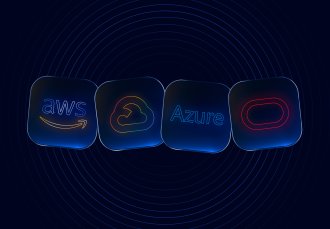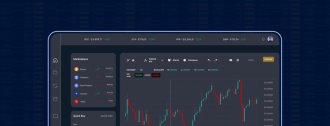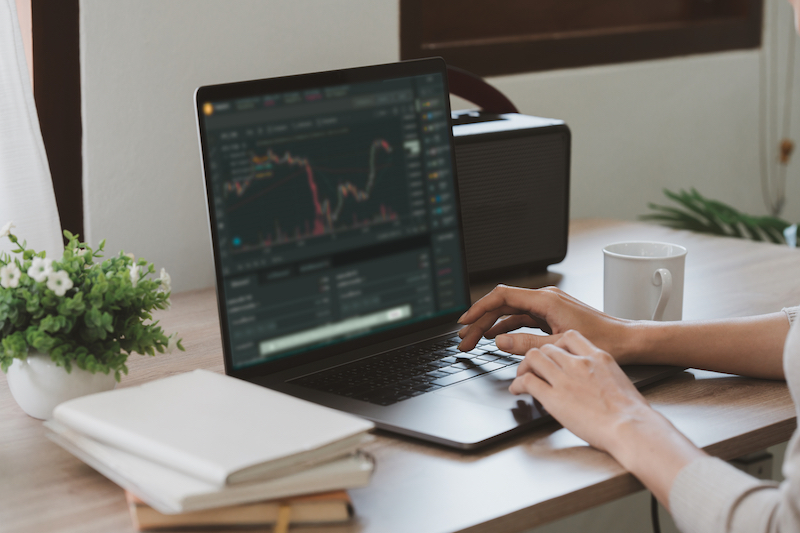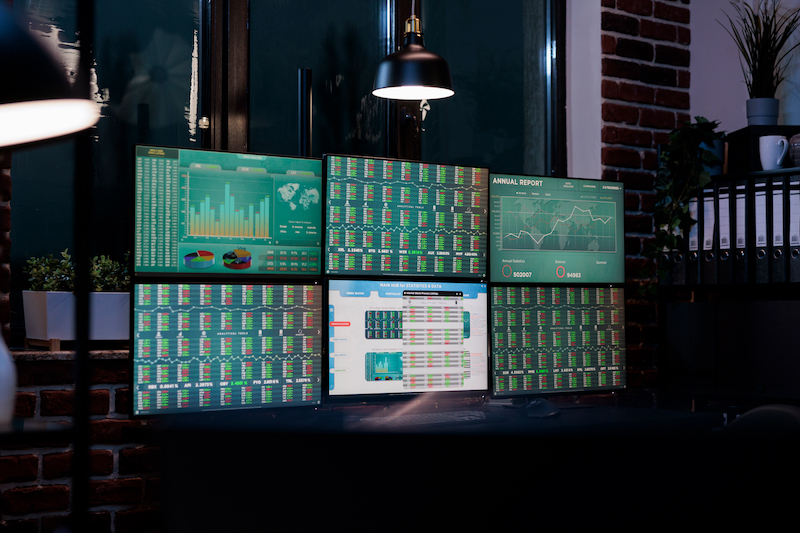
Contact us
Our team would love to hear from you.

The degree of sophistication and the level of accessibility of trading platforms can vary. In any case, the creation of a trading platform needs keeping abreast of innovations and market demands.
Building a trading platform is like doing a puzzle. It means putting a huge number of puzzle pieces together: high performance, data processing, compliance, data security, etc. An experienced development partner can help you bring it all together and create a single, fully functioning solution.
In this article, we’ll take a look at trading platforms from the inside and outside and offer insights into how to create a trading platform that works for you and your clients.
Traditionally, financial brokers acted on stock exchange trading floors or made trades by phone. They manually did research into financial markets, generated stock ideas, and devised trading strategies. The landscape of the trading world has changed a lot since then, shifting towards online trading. Below you will find some key differences between traditional and offline trading.
This is where online trading beats traditional one. All you need is a computer, tablet or smartphone and an internet connection to carry out transactions in a matter of seconds. In offline trading, investors need a broker to make a buying or selling decision. Offline trading is also more expensive because the brokers’ services may cost investors a pretty penny.
Online trading is much more secure as the individual trader has full control over transactions. In offline trading, brokers carry out transactions on behalf of their client, which might raise the risk of fraud.
A significant advantage of online trading is that updates on market data are displayed almost instantly on a single dashboard. Offline trading puts individuals one step behind the market as it keeps changing every second.
A trading platform is network-based software designed for trade execution and market position management. Trading software can be run from a web browser, desktop app, or mobile app. Platforms empower traders and investors with numerous options including placing trades, browsing catalogs or financial instruments, monitoring accounts, etc. Custom trading platforms are tailored to fit the needs of specific markets — futures, stocks, options, or currency ones.
Online trading platforms charge traders non-trading fees like subscriptions fees or fees for trading-related activities, including deposits, withdrawals, commissions, and transactions.
Basically, there are two types of trading platforms: proprietary and commercial platforms.
There is another approach to classifying trading platforms: traditional assets and cryptocurrency-oriented platforms.
A great trading platform comes with a wide range of sophisticated tools, helping traders optimize their strategies and maximize returns staying in line with financial regulations and ensuring data protection. The right features can really polish up the trading process. Some of them are listed below.
Security and data protection are of paramount importance for the authorization process. To keep personal information and trading data safe and secure, an expert development team equips your trading software with a flawless registration form, multifactor authentication, bank-grade encryption, etc.
A personal profile is a customizable space for traders to keep, update and edit personal data. Since the profile may contain sensitive data, this is another area where privacy and data security come into play.

Convenient interface and dashboards for trading platforms
Great dashboards display active orders, trade history, deals and other required widgets with live market data in the same view, which enables the monitoring of financial goals and improves trading experience. Market data is shown in the form of real-time charts.

Real-time charts for trading platforms
Charts visually detail price fluctuations and other indexes helping traders instantly react to market movements. This data should be well-organized and easy to read, presenting important changes in a visual manner so that the trader can respond quickly and make informed decisions.
Popular chart types are:
Real-time charts are an appealing visual feature of a trading platform making your product stand out in an increasingly competitive market.
Watch lists allow traders to monitor specific assets of interest. They are must-have tools for independent analysis and streamlining trading. With a watch list, or “favorites,” traders save their time and make better trading decisions.
Awareness of overall market trends and current events that can affect the economy is crucial to making right decisions. Relevant and timely market and company news can help with that. Some platforms include newsfeeds with the most up-to-date read. Some of them even offer live audio feeds to make breaking news immediately available to traders and speed up decision-making. These are optional features, but they can help add authority to your brand and encourage more interaction within the app itself.
Daily alerts (e.g. price alerts, order execution alerts, news alerts, etc.) and notifications can enhance performance within the trading platform. Not only do they notify about market developments, technical indicators, or reaching a specified price target, but they help traders react quickly when the need arises. To reach a balance and prevent traders from being annoyed by too many notifications, an expert development team will guide you on how to configure alerts.
With these features, a platform user can analyze the current day’s trades and historical trade data. By combining current and historical data, an analytic tool can make predictions and help traders make the right choice.
Any sort of financial advisement is going to fall under strict regulations. Working with a trusted fintech partner can help companies create tools that are valuable to their users and stay on the right side of all regulations.
Adding search accompanied by advanced filters helps display relevant information related to rates, orders, currencies, indexes, and commodities. With these features in hand, traders can cut straight to the point and get the latest data without being overwhelmed with information.
This feature is what traders typically rely on while registering, handling, and tracking orders. With pricing, analytics, liquidity, automation and execution options in hand, traders and investors have the edge in today’s fast-paced trading environment.
Any trading system is conceptually a computational block that calculates data and interacts with the market via two different streams. It gathers information on market events and deals with orders and responses.
Based on the processed market data, trading software gets all the details on:
Behind the facade of a trading solution, sophisticated logic and architecture enable the processing speed of trading operations within time intervals that are beyond the dimension of human control. In other words, modern trading solutions are capable of processing a huge number of requests per second. This is achieved due to:
Comprehensive market research, which includes competitor analysis, target audience identification, has to be carried out to ensure the success of a trading system in the future. In addition, a product idea needs to be turned into a business model and development roadmap.
As the trading market is heavily regulated, trading platform owners are in charge of the legal part: in case of violations, the consequences range from fines to stricter penalties to business termination. So the platform owners define the rules and regulations the developers need to consider while creating trading solutions. In the USA, trading software developers have to meet the standards of the Securities and Exchange Commission. In Europe, the standards and regulations of the following supervisory authorities need to be complied with:
Some companies want to have an MVP in hand before they bring the legal department on board or hire a lawyer. However, experienced developers know that legal and regulatory compliance must be baked into the project from the very start. What sounds like a great idea from the user or business perspective might not actually be feasible or might need certain tweaks. Get the right information first, before you invest time and money in development.
The next step is to decide whether a future system will be an extension of the existing platform or a fully-fledged solution. Also, it is time to decide what kind of software — web, mobile or desktop app – will suit your project. Depending on this decision, the project team determines infrastructure requirements.
When it comes to trading platform design, a convenient interface and smooth navigation should be on top of mind to eliminate traders’ mistakes and facilitate their transactions. For this purpose, the software structure and user flows have to be carefully thought through and aligned with the purpose of a trading platform.
In this project stage, software architects select programming languages and tools appropriate for a project. A development team is then carefully picked based on the required skills for the selected technologies. For example, mobile iOS developers should know Swift and Objective C, while Android experts have to know Kotlin or Java.
Next, front-end engineers implement the structure, behavior, and visualization of everything users see on the screen when they open up a trading application. Back-end developers, in their turn, build the server side, which is invisible to a user, but holds everything together. Back-end development involves creating software architecture and logic, as well as implementing interactions with databases or data platforms.
A technology stack used for creating trading solutions may include .NET, Java, Python, GoLand, etc., backed by high availability data platforms. Depending on the purpose, relational or flat data storages, data lake engines, etc., can be deployed on high availability infrastructure.
It’s difficult to overestimate the importance of excellent quality assurance in fintech applications. Defects in financial software can have far-reaching consequences for traders and for the software company. Rigorous work done by quality control engineers can help lower the chances of problems later when the product goes live.
Our top-level QA engineers with a deep knowledge of testing processes not only check the platform’s correct operation before it goes live but they also make the testing process consistent by employing CI/CD/CT practices.
To cover those activities that cannot be replaced by scripts, we apply different types of manual testing. A balanced combination of automated and manual testing activities ensures high-quality product development and a successful release. It should not go unmentioned that the collaboration of the customer and the software development company doesn’t end with the release since technical support, troubleshooting, and regular updates are integral to trading apps.
We believe it is always good to resort to benchmarking and compare the most successful products in the segment.
Below are the top trading platforms available today.
Robinhood allows trading traditional stocks, options, gold, and cash. On top of that, there is an option to invest in cryptocurrency. The solution is accessible to the general public and allows investments without minimum rate limitations.
Interactive Brokers’ suite of platforms attracts professionals with its IB Trader Workstation desktop solution. More casual traders are offered a user-friendly IBKR Event Trader web platform.
TD Ameritrade is a full-service broker which has built a brand as a leader in trading innovation, client experience, and education. It is best known for their flagship product — the thinkorswim platform. Being intended for stock, ETF, futures and forex traders, this powerful solution has advanced trading capabilities, sophisticated research tools, screening features, backtesting capabilities, real-time news, quotes, market heat maps, and more. It is available in web, desktop and mobile versions.
Trading platform development is a complex process that has to deliver excellent performance, reliability, and low latency combined with security and legal compliance. It’s not for the faint of heart. We recommend working with developers who have handled projects of this scope in this industry before. Rewards for finding the right partners could be great, and it is a secret weapon that allows you to succeed in a highly competitive trading world. At EffectiveSoft, we have professional trading platform developers that can cope with projects of any complexity. Just drop us a line!
Our team would love to hear from you.
Fill out the form, and we’ve got you covered.
What happens next?
San Diego, California
4445 Eastgate Mall, Suite 200
92121, 1-800-288-9659
San Francisco, California
50 California St #1500
94111, 1-800-288-9659
Pittsburgh, Pennsylvania
One Oxford Centre, 500 Grant St Suite 2900
15219, 1-800-288-9659
Durham, North Carolina
RTP Meridian, 2530 Meridian Pkwy Suite 300
27713, 1-800-288-9659
San Jose, Costa Rica
C. 118B, Trejos Montealegre
10203, 1-800-288-9659